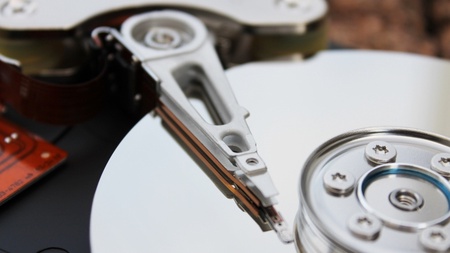An attempt to uncover the 'holy grail' of a lossless energy source has inadvertently led to a study which could result in the next generation of high-speed, mass storage hard drives.
Chemists at the University of Aberdeen were examining a new compound to explore whether it could be a ‘superconductor’ – a material that has no electrical resistance – when they realised it had a completely different potential.
“Lots of research is being done at the moment into spintronic materials for smaller, faster, cheaper and more efficient computing applications,” explains Dr Abbie McLaughlin, a chemistry senior lecturer at the University of Aberdeen.
“Originally, we were looking at a manganese oxyarsenide material to explore whether or not it could be a potential superconductor.
“Superconductors that work at room temperature are something of a ‘holy grail’. Most metals have resistance, so when you’re transporting electricity in overhead transmission lines on pylons, for example, you lose a lot of that to heat as a result of the resistance – so it’s not very efficient.
“A superconductor doesn’t have this, so it’s a much greener way of transporting electricity. If we could discover a superconducting material that works at room temperature it would transform our world and could also lead to highly efficient electric cars or supercomputers beyond anything that exists at the moment.
“Scientists have been concentrating on materials containing planes of copper and oxygen (cuprates) as these materials exhibit superconductivity at the highest temperatures (known as high temperature superconductivity). However so far it has not been possible to observe superconductivity above 139 Kelvin (-134 °C). This all changed 5 years ago when a new set of iron arsenide materials were also shown to exhibit high temperature superconductivity. This caused much excitement worldwide because if there’s a whole new set of materials out there then it’s still possible the room temperature superconductor could be achieved.
“We switched the iron for manganese to see how the properties changed. It didn’t show superconductivity but it did show another exciting property - Colossal Magneto Resistance.”
The information stored on computer hard drives is currently read using magnetic sensors which display an effect called giant magnetoresistance. Such magnetic sensors exhibit a reduction in resistance by up to 50 % upon applying a small magnetic field. The introduction of giant magnetoresistant sensors enabled a thousand fold improvement in the storage capacity of disk drives.
In the 1990s materials called manganese oxides were discovered which display ‘Colossal Magneto Resistance’. These materials showed reductions in resistance by up to 99.9% in field, are up to 1,000 times more powerful than current devices and could trigger a revolution in computing technology. However these materials required a large magnet (around the size of a small table) to work. As such, these superfast, hard drives have not yet come to fruition.
Dr McLaughlin discovered that the manganese arsenide she had been investigating also show Colossal Magneto Resistance.
“We’re hoping we can manipulate the chemistry and somehow develop a material that will show this Colossal Magneto Resistance in low fields, using smaller magnets. At the moment we only see colossal magnetoresistance at a really low temperature, so the grant is about seeing if we can make other compounds with similar structures that will work at higher temps. So we’re tinkering with the chemistry and seeing if there’s anything we can do to raise the temperature.
“New materials like this with new mechanisms of colossal magnetoresistance mean there’s a renewed interest in this field. Even if we can’t get it to work at high temperatures, the fundamental mechanism could maybe be applied to something else.
Dr McLaughlin’s work has been supported by a £300,000 grant from the Engineering and Physical Sciences Research Council (EPSRC).


